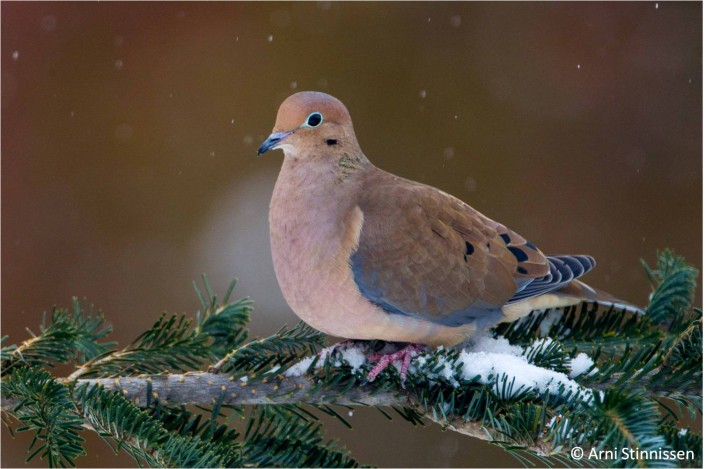Although we do have many different species of birds visit us all winter long, we can always depend on three species to stay around our property year-round: White breasted Nuthatch, Black-capped chickadee and one other favourite, especially in the winter, The Mourning Dove.
 Mourning Doves, named and known for their plaintive wooing sounds, which do indeed sound like the utterances of those in deep mourning over the loss of a loved one, are also known by the name, Turtle Dove in some parts of the country.
Mourning Doves, named and known for their plaintive wooing sounds, which do indeed sound like the utterances of those in deep mourning over the loss of a loved one, are also known by the name, Turtle Dove in some parts of the country.
They are one of the most profuse bird species in North America, with an estimated 475-500 million individuals. They are classified as “game birds” and are hunted regularly in many U.S. States and in British Columbia. With a very healthy population in Ontario, and with some political lobbying, Environment Canada has allowed hunters the opportunity to hunt Mourning Doves in some parts of Ontario this year. Mourning Doves are very fast flyers, reaching speeds of about 55 miles per hour which make them very difficult to shoot. Successful hunters are allowed to bag 15 birds per day. Although this seems a very high number, it should not have any serious effect on the Ontario population of one of our favourite non-migratory birds.
Mourning Doves pair for life and can often be seen perched very close to each other on power lines or tree branches, sometimes cooing to and preening each other. They are frequently depicted in pieces of art as “Love Birds”. In our culture, they are also a symbol of Peace!
Mating season begins in early spring. Males perform aerial flight displays, circling high above the female. Frequently he will land beside her and begin bobbing his head, preening her feathers, cooing to her and puffing up his breast. He will then lead the female to his suggested nesting location, which may indeed be the vacant nest of some other species of bird or even their nest from a previous year. If she accepts the location, he will bring her twigs, pine needles and soft fibrous materials, and give them to her for the nest construction, all the while, standing on her back!
The female lays two pure white eggs which are incubated by both parents for about 15 days, the male incubating during the day and the female over night. The young, known as squabs, are fed dove’s milk, (regurgitated partially digested seeds from the crop) for the first few days of life. The squabs fledge in about 14 days. A pair of Doves may have up to three broods per year in Ontario. In warmer climates, they have been known to have 5 or even 6 broods.
Mourning Doves are ground feeders eating seeds for the most part, but they will take some insects and snails. They will eat enough to fill their crops and then fly to some safe location to digest the food. They are often seen on the side of roads picking up sand and bits of gravel to help in the digestive process.
Being ground feeders, they are prone to attack by domestic and feral cats. They are also prime targets for Cooper’s Hawks, especially in the winter months. During breeding season, their nests are frequently raided by Grackles and Blue Jays.
To enjoy these lovely birds all winter, attract Mourning Doves to your yard with low feeding platforms filled with a combination of the seeds of safflower, sunflower, corn, and millet! If you can, provide a fresh supply of water on a daily basis!
Written by David A. Homer.
The Couchiching Conservancy is a non-profit, non-government land trust dedicated to protecting nature today, for current and future generations. Our work is powered by community members, supporters, businesses, volunteers and foundations. Since 1993, we have helped protect over 14,000-acres of wilderness – an area double the size of the City of Orillia! We operate on the territory of the Anishnaabeg. Learn how to get involved here.

